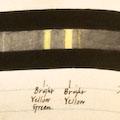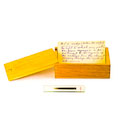

 The Great Lick Refractor
In 1609, Galileo Galilei in Italy and Thomas Harriot in England turned a new Dutch
invention—then variously called a truncke, a tube, or a perspective
glass—on the stars. In effect, a telescope gave an observer a much
larger eye in the form of a lens which collected far more light,
concentrating it at a focus. Even the modest increase in brightness and clarity
afforded by the first small telescopes revealed a hitherto invisible universe
full of unimagined wonders.
Astronomers made careful drawings at the eyepiece or used instruments to
measure what they saw. As the size and light-gathering power of telescopes
increased, so did the sophisitication and precision of instrumentation. By the
nineteenth century, the astronomer's toolkit included micrometers for measuring positions,
angles, and angular distances; photometers for gauging luminosities; and spectroscopes
for analyzing starlight. As pre-telescopic observers had done before them, astronomers of
the telescopic era were pushing visual observing to its limits.
The Great Lick Refractor
In 1609, Galileo Galilei in Italy and Thomas Harriot in England turned a new Dutch
invention—then variously called a truncke, a tube, or a perspective
glass—on the stars. In effect, a telescope gave an observer a much
larger eye in the form of a lens which collected far more light,
concentrating it at a focus. Even the modest increase in brightness and clarity
afforded by the first small telescopes revealed a hitherto invisible universe
full of unimagined wonders.
Astronomers made careful drawings at the eyepiece or used instruments to
measure what they saw. As the size and light-gathering power of telescopes
increased, so did the sophisitication and precision of instrumentation. By the
nineteenth century, the astronomer's toolkit included micrometers for measuring positions,
angles, and angular distances; photometers for gauging luminosities; and spectroscopes
for analyzing starlight. As pre-telescopic observers had done before them, astronomers of
the telescopic era were pushing visual observing to its limits.
Click on the thumbnails below for more on late nineteenth-century visual observing at Lick Observatory.
 Eyepieces
Eyepieces
 Drawing of Jupiter
Drawing of Jupiter
 Duplex micrometer
Duplex micrometer
 Spectrum drawing
Spectrum drawing
 Photometer wedge
Photometer wedge
